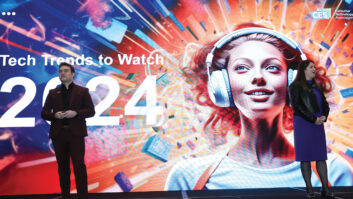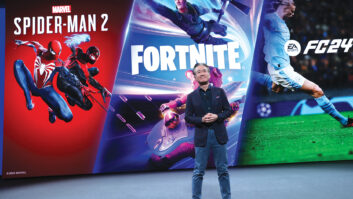For me, with my custom installation glasses focused in a different direction, last week’s International Consumer Electronics Show (CES) was more important as a launch pad for new ways to connect the TV to mobile devices and the rest of the home, as it was about smart TVs, web tablets, 3D, and Android.
Before I explain my technology observations further, my general sense of the annual event was that it had fully regained its status as the most annoying place to be (and that’s a compliment on its high attendance numbers.) Lines were unbearably long, the show floor was impossible to navigate, and the buzz about web tablets and smart TVs was strong in the mainstream media (and among my friends and family who follow the mainstream media). So, having achieved an 8.5 on my personal annoyance meter (PAM, which is handicapped by the number of public smokers I encountered during my stay in Las Vegas), I’d say that CES was a great success this year.
In fact, preliminary attendance figures indicate more than 140,000 industry professionals attended the 2011 International CES. According to show management, more than 30,000 attendees came from outside the United States, with the show attracting more than 80 international delegations.
Major technology trends emerged from the CES show floor including the launch of more than 80 tablets, wireless 4G LTE, connected TV technologies, smart appliances — featured for the first time in show history — and electric vehicles. Ford’s Alan Mulally unveiled the company’s first electric car at the 2011 International CES with its Ford Focus Electric.
But for me, it’s all about finding trends and technologies that directly affect the wellbeing and create opportunities for the CEDIA channel. On this score, what I saw worried me a bit.
Thinking Like a CI Guy
For years, rather than stand back as a completely objective journalist, I’ve learned to think like a custom installer (or ESC as CEDIA now calls its members) and thus bristle at any product or technology that seems to threaten the livelihood of my readers. This year at CES, I bristled quite a lot, eventually coming to the realization that rather that ignoring or rejecting products that promise DIY-level integration of cutting-edge simplicity, I would embrace them, accept them, learn more about them, and come back and attempt to guide the integration channel toward finding ways to incorporate these solutions in their projects.
Specifically what I observed were competing and complementary technologies that consortia, licensing organization, and specific manufacturers are promoting as ways to connect new and future TVs to mobile devices (including smart phones and laptop computers) wirelessly or via simple wiring. I also learned about a couple of ways that companies are looking to improve the intuitiveness of TV formatting, particularly when viewing 3D content.
Streamlining 3D
The first company I talked with about performance technology was THX, which in addition to its 3D certification program for manufacturers, has enhanced its THX Media Director program that has been created to enable TVs and sound systems to automatically select the appropriate playback features and modes specific to each piece of content. Working with content creator, distribution outlets, and playback devices, THX Media Director provides metadata tools for describing specific creative and technical characteristics of audio and video content. In other words, if a movie or TV show is mixed in surround and shot in 1080i 16:9 format, then a metadata tag will tell a TV carrying the THX Media Director logo to optimize the video and audio for those playback settings. Though program was not originally intended for 3D (its patent goes back to 2001) THX has added 2D to 3D switching to its program. In my demo, the set-top box incorporated the technology, so when you switched channels from a 2D program to 3D, then box recognized the format change and displayed the content in the manner you’d expect to see it. Expect to see the THX Media Director logo start appearing on Blu-ray discs, display devices, and set-top boxes later this year.
On a similar note, I met with 3D pioneer, Sensio, which has employed 12 years of experience with the technology to develop Autodetect. Like THX Media Director it is designed to detect the input format, whether 2D, side-by-side, Sensio Hi-Fi 3D or top-and-bottom, and displaying images in the corresponding output format. It is designed for integration into AVRs, set-top boxes, 3DTVs, and Blu-ray players, as well as professional video-processing equipment. Even more unique, were two other technologies from Sensio. The first, S2D Switch, enables a spatially-compressed stereoscopic (3D) video stream to be displayed in 2D (left- or right-eye). The Sensio S2D Switch gives consumers viewing flexibility, when batteries on active shutter glasses are low or there simply aren’t enough glasses to go around the room. The second technology is Sensio Hi-Fi 3D, a technology available on the video-on-demand (VOD) platform of RoxioNow, a major player in over-the-top (OTT) services.
IOGEAR also offered its Wireless 3D Media Kit (GW3DKIT), the company’s first device to wirelessly stream HD audio/video and offer 3D support up to 100 feet away. Six different A/V devices can be connected and stashed away for discrete, uninhibited performance. Leveraging its own integrated private Wi-Fi (802.11n), the IOGEAR Wireless 3D Media Kit broadcasts with almost no latency and no interference from nearby wireless routers. Content can be streamed to a total of four wireless 3D receivers simplifying the process of setting up multi-room or multi-display environments with additional freedom to install displays in non-traditional locations without worrying about line-of sight placement. The Wireless 3D Media Kit consists of a wireless 3D transmitter and wireless 3D receiver with various connectors including HDMI, Component, Composite, VGA, and USB. Users can connect a Blu-ray player, DVR/Set-top Box, DVD player, Media Server, computer or even a VCR and stream the content 100 feet through the air.
Wired vs. Wired Connectivity
Moving away from 3D, I also learned about a consortium so new that it was tucked away in a small meeting room at the back of South Hall. MHL is focused on bringing to market a wired audio/video interface optimized for mobile devices. The goal is to keep the mobile device charged and ready for use while viewing HD video and high-quality digital audio from the mobile device and displayed on a DTV. The specification also allows consumers to control the content through their TV’s remote control. The MHL Consortium is made up of Nokia, Samsung, Silicon Image, Sony, and Toshiba who have developed this new specification. The companies represent 69 percent of all handset sales globally and some of DTV’s biggest manufacturers. The technology is designed to integrate into HDMI inputs on TVs while connecting to mobile devices (including camcorders) via a micro-connector. Expect to see MHL-certified products on retail shelves by the end of the first quarter.
One of MHL’s big selling points against wireless competitors was its ability to charge a camcorder or mobile device while it was connected and streaming to the display device. My meeting with WHDI’s Les Chard (formerly of HDMI), however, seemed to neutralize that benefit, as he explained that at least one of WHDI’s licensees is offering a smart phone cradle that streams content wirelessly to a TV, while simultaneously charging the device. I witnessed a demo on a beta-level dongle attached to a mobile phone playing a car racing game. When you tilted the device left or right to turn on the grand prix road course in the game, the movements were instantly reflected on the streamed image of the WHDI-enabled flat-panel TV in the Hilton Suite.
The MoCA standard also was on display at CES, showcasing how many device manufacturers and set-top box companies have begun integrating the coax-based networking technology for features such as home security and automation services, social networking applications, and personalized subscriber widgets like news, sports, and weather updates. MoCa devices are already available through many retail outlets, but 2.0 offers improved performance in an expanded range of operating frequencies (500 Mhz to 1,600 Mhz).
Back to wireless, Summit Semiconductor is a company that embraces the untethered approach to integration of home entertainment technologies, such as speakers and DTVs. I first met with Summit at CEDIA EXPO 2009, where I listened to wireless speakers from licensee Aperion, an internet-direct speaker company. At last week’s CES I experienced that brand’s new “My Zone” feature, which essentially integrates into a remote control so that when one button is pushed the audio coming out of the company’s very small surround processor re-calibrates the sweet spot of the room to the spot where the remote control holder is sitting. But Summit Semiconductor is also forming partnerships with other manufacturers to provide products that would be FCC certified for the UNII (Unlicensed National Information Infrastructure) wireless band to avoid interface with cordless phones and Bluetooth devices. Near-future products from other Summit-licensed manufacturers may include wireless 7.1 speaker packages below $1,000, wireless surround bars, wireless subwoofers, and DTVs with built-in wireless surround connectivity capabilities.
I once considered the company a potential, if under-developed threat, to the CEDIA industry. Now I see that they’re embracing the CI channel while offering a technology that is no longer alone in its goals of offering consumers more simplicity, nor far from market reality. Summit’s Tony Parker told me about a conversation he had with a familiar ESC in his local Portland, Oregon, market. This individual, he told me, listened to one of the wireless systems, and replied, “I knew this day was coming.” But he then said that he had come to terms with wireless as an option, but was going to use the freed-up installation time to upsell better-quality equipment within a given budget. Maybe that’s wishful thinking, but I think it’s either that or we all just throw up our hands and give up.
Atlona Technologies also released the third generation of its AT-HDAiR wireless USB–to-HDMI converter, the AT-AiR3. Answering the call for a full 1080p wireless signal, this device allows users to connect any USB-enabled computer or laptop wirelessly to an HDTV or projector via VGA or HDMI. Capable of transmitting a signal up to 30 feet, the AT-AiR3 is designed for viewing streaming media from Hulu, YouTube, and other popular sites; stored movies or pictures from a PC or laptop; and computer-based learning programs such as Rosetta Stone or lynda.com online training.
It’s a Threat that Must Be Embraced
One guy who acknowledges the threats posed by new technology on the traditional CEDIA channel, yet embraces these new opportunities as well, is Richard Millson, a Vancouver ESC and Residential Systems contributor. When I met with Millson at CES, he pointed out a company that he believes will have the biggest impact of all on home integration: DiiVA (Digital Interactive Interface for Video & Audio).
Millson and I visited that booth together and he was noticeable awed and very enthusiastic about how DiiVA (which is bi-directional) promises to integrate entertainment content and multiple data formats into a single Cat-6 cable. Here’s how it works: uncompressed video, audio, USB, Ethernet, device control, content protection, power delivery, and content management are coordinated throughout the DiiVA network by middleware and the cross-platform applications that it enables. Users can access content on any DiiVA network device for playback on any DiiVA TV. More specifically, HD and 3D movies on a DiiVA-equipped Blu-ray player could be accessed from any DiiVA-equipped TV in the house. Or, video games could be played from any DiiVA-equipped TV, because the USB controllers for the game can be connected directly to the USB port on the TV, instead of to the game console. Also, mobile devices can be charged throught the DiiVA connection while outputting HD audio and video and synchronizing data to any source on the DiiVA network. In addition, applications on PCS could be launched from TVs and unused devices on the network could be intelligently power down to automatically enable power savings.
DiiVA charter members includes CE and home appliance manufacturers Changhong, Haier, Hisense, Konka, Panda, Samsung, Skyworth, Sony, SVA, TCL, and chip developer Synerchip, with several other household names in CE joining as contributors to the spec.
Will “DiiVA Inside” become the buzz on this CE business in the coming years or will the technology fade away? Millson believes its for real and will aid his company in creating even better designs for clients without having to jump through as many hoops as he does now. That’s not to say that he and I both don’t believe that the CEDIA channel is in for major changes. It is. It’s just anticipating these changes, and realizing the value that you bring to the integrated home that is going to be the key to your future.







